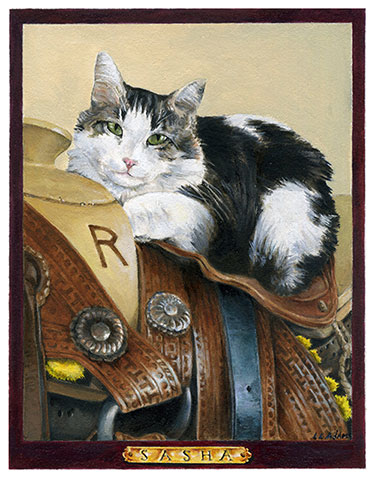
Cat's Corner: Meet the official greeter at Rolling Hills Community Association
 By Daniel Brannigan
By Daniel Brannigan
Sasha the cat knows just when someone needs special attention or when to entertain children whose parents are attending to business at Rolling Hills Community Association in Southern California. The gated, equestrian-friendly community, founded in 1936 and consisting of 690 single-family homes, adopted the now 4-year-old cat when a resident passed away. Sasha has made a perfect adjustment from outdoor cat to association ambassador. She has a column in the community’s monthly magazine and a Twitter account, @RHCAcat. Sasha was among the more than 200 entrants in the #CAIPets cover photo contest. Rolling Hills Manager Kristen Raig, CMCA, AMS, describes how Sasha fits in and the impact she’s having.
How long has Sasha been the association office cat?
She was adopted by the office in 2012. We hadn’t had an office cat for more than two years, yet we still had residents and contractors asking where the cat was when they visited the office. After a brief discussion, we agreed to give it a trial run. Once we met her, she settled right in as if this had been her home all along.
Who is her primary caregiver?
The administrative staff looks after her during the week. She goes in and out of the office during the day and sleeps inside at night. We have coyotes in the neighborhood, so we’re careful to make sure she’s in at night. On weekends, the gate staff looks after her.
How did the community react to Sasha’s addition?
Sasha got a very warm reception. She always seems to know if someone is having a hard day and would benefit from giving her head a rub. We’re sensitive to people who are allergic or averse to animals, and she’s contained in the manager’s office when needed.
Have you noticed a difference in employees’ and residents’ moods with Sasha there?
Yes. Sasha is an easy way for people to connect. Residents and visitors love to share stories about their own pets when they see her. Even when people come in who may have an issue with a bill or a violation notice, Sasha jumps on the counter to greet them. It’s hard to stay mad.
What does she Tweet about?
Events that take place at the Rolling Hills office, pet safety, and of course, selfies. It’s a fun, low stakes way for the association staff to get comfortable with Twitter.
Is Rolling Hills a pet-friendly community?
Very. Residents love the equestrian nature of the community. In addition to dogs, cats, and horses, we also have donkeys, goats, chickens, parrots, and alpacas. About half of our residents have pets.
Does the association have a pets policies?
The CC&Rs prohibit the keeping of swine. Otherwise, there aren’t any other pet restrictions. The city has an ordinance that limits households to three dogs, and if any dog is aggressive or is a nuisance, there is a policy that allows for complaints and a resolution. The association defers to the county’s rules about the keeping of livestock.
_______________________________________________________________
Daniel Brannigan is editor of Common Ground magazine. Lisa Adams illustrated Sasha's portrait. www.lisaadamsart.com. The article and art initially were published in Common Ground's May/June 2017 issue. Further reproduction and distribution is prohibited without written consent. For reprints, go to www.caionline.org/reprints.
People are crazy about their pets
By Daniel Brannigan
There are the nicknames, the Facebook photos, Instagram accounts, the outfits and accessories, the cat-sitting, the doggie daycare, and all of the maintenance and care that goes into them. It’s no wonder some people affectionately call pets their “fur children.”
Pets have become such integral parts of our lives, we spent nearly $63 billion on them in 2016, according to the American Pet Products Association (APPA). That’s up from roughly $21 billion in 1996. Pet owners will explain it’s all worth it because they know pets make them feel good physically, psychologically, and socially. Scientific studies prove it.
There are a lot of pets too. The APPA estimates there are more than 85 million cats in almost 43 million U.S. households and more than 77 million dogs in 54 million households, not to mention the fish, birds, rabbits, and more being welcomed into homes.
With so many pets and so much emotional attachment involved, it’s no wonder pets—and their owners—give community associations the occasional problem. Whether your association needs help with restrictions, carefully crafted rules, service and assistance animals (just note they’re not considered “pets”), the increasing number of livestock and exotic animals, leash rules, or dog waste, we’ve got you covered in Common Ground's May/June 2017 issue.
Meanwhile, given the level of interest and investment owners are dedicating to their pets, communities are responding by putting a priority on pet-specific amenities, programming, and services, such as dog parks, pool parties, and grooming stations.
It’s almost as if the articles in this pets-only issue of the magazine prove it’s a pet’s world, and we’re just living in it.
_______________________________________________________________
Daniel Brannigan is editor of Common Ground magazine. His two pugs, Fozzie and Franklin, were professional advisors for the pets issue. The above article initially was published in Common Ground's May/June 2017 issue. Further reproduction and distribution is prohibited without written consent. For reprints, go to www.caionline.org/reprints.
You taught your human children how to behave
properly; why not teach your canine children as well?
By Jodha, an HOA Dog
I was watching my human researching online recently (I remember because it was the stupid cat's birthday) when she came across the home-design website Houzz. Houzz surveyed its pack members and arrived at some conclusions with a high Duh! factor: "Pet owners are happier, have higher self-esteem, and are less lonely. They also get more exercise, which leads them to be physically fit."
What made my ears pick up were the statistics on how many dog owners actually remodeled or upgraded their homes for their pets—35 percent! Bow wow! You should see the pictures (what's a home design site without gorgeous pictures?): some lucky dog sleeps in a wainscoted nook under the oak stairs on a big velvet cushion. And all I get is an old towel in a crate near the back door.
Actually, that's OK. I also get security, lots of play time and toys, great food, love, attention, … and I guess I have a good health package judging by the trips to the vet. I also have to go to school twice a week to learn to be a good community association resident. My human calls it Charm School. I call it Boot Camp.
And, that's OK, too. I'm a dog. I want structure, a family hierarchy. This is one of the hardest things for humans to understand—well, not mine, of course. I live to please my human. But, I can't do that if I can't communicate with her or if I don't know what she expects or wants. For that, training is essential.
Humans don't give dogs enough credit. In the absence of training, we will adapt to your routine and respond to your behavior the best we can. And when we can't cope, we'll act out—we'll bark or chew table legs (that wasn't me, I'm just saying). We become neurotic. We're trying to tell you something.
I just want to be understood so my needs will be met. I want to know what I'm supposed to do. Everyone is happier when you train us, instead of the other way around.
I'd like to see the canine obedience session at the CAI conference in Las Vegas in May. I'd slobber in envy. I'd be inspired to behave! OK, admittedly, these dogs are PhDs; but, in an HOA, a GED is equally valuable. You know, the basics: sit, stay, come, down, okay, no (not my favorite), heel, and maybe "pick up after yourself." Wouldn't that one make training popular?
Training creates good behavior. And, with dogs, everything is—or should be—about behavior. How much I weigh, how tall I am, and my ancestral heritage have no bearing on my behavior. But, training does. Actually, my heritage is rather impressive, but I'm still an unmanageable nuisance without training. (And, anyway, I'm working on that weight thing.)
There are lots of websites and videos online showing you how to train your dog. If you can't pull it off yourself, there are also lots of dog trainers listed online. You, your dog, and your association manager will find life is much easier if you teach us how to behave.
_______________________________________________________________

Jodha is a long-hair German shepherd named after a 16th century Indian princess. She is currently working on her basic obedience certificate at the Metropolitan Executive Dogs training facility in West Virginia.
© 2017 Community Associations Institute. Further reproduction and distribution is prohibited without written consent. For reprints, go to www.caionline.org/reprints.